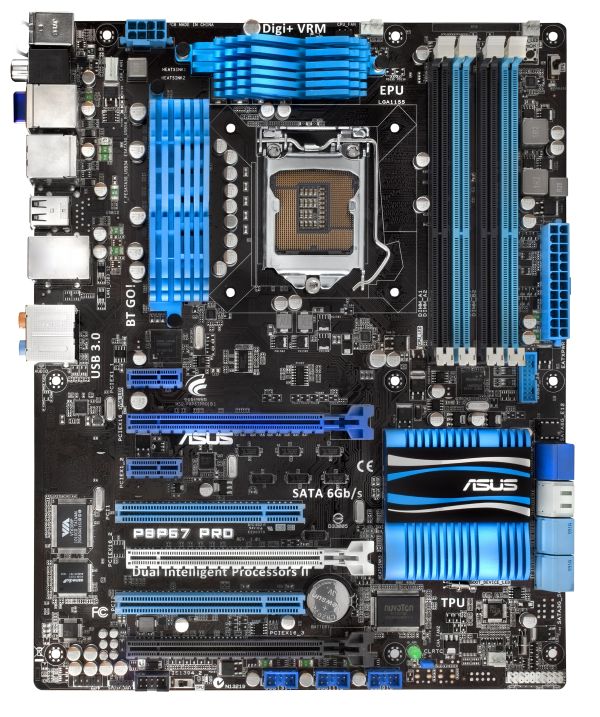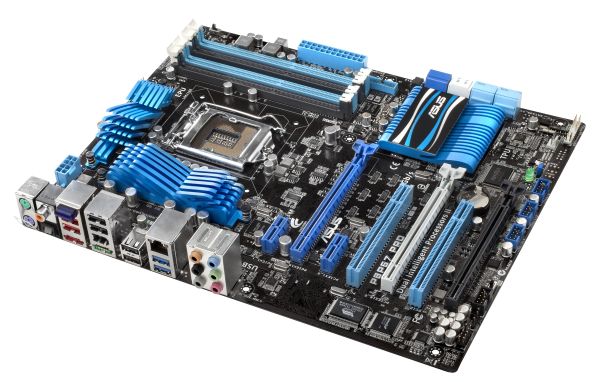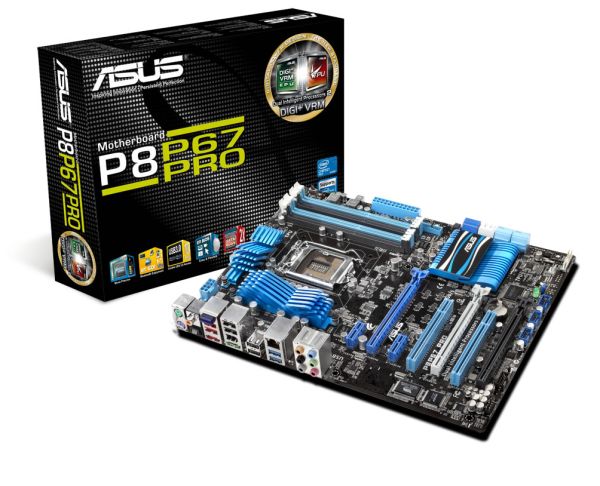The Battle of the P67 Boards - ASUS vs. Gigabyte at $190
by Ian Cutress on January 20, 2011 4:15 PM EST- Posted in
- Motherboards
- Gigabyte
- Asus
- P67
The ASUS P8P67 Pro fits near the beginning of the line-up in the ASUS launch, which in terms of ATX sized boards include the P8P67, the P8P67 Pro, the P8P67 Evo, the P8P67 Deluxe, the Sabertooth P67, the P8P67 WS SuperComputer and the top end Maximus IV Extreme. Therefore, with that in mind, we would expect to be looking at something above the base – slightly more (or better) features than the cheap boards available, enough to warrant the price difference. An overview of the P8P67 series is below:
| P8P67 Series | ||||||
| P8P67 LE | P8P67 | P8P67 PRO | P8P67 EVO | P8P67 Deluxe | ||
| Price | $140 | $160 | $190 | $210 | $235 | |
|
SATA 6 Gb/s SATA 3 Gb/s eSATA |
3 4 1 |
4 4 1 (bracket) |
4 4 2 |
4 4 2 |
4 4 2 |
|
|
CrossFireX SLI |
Yes No |
Yes No |
Yes Yes |
Yes Yes |
Yes Yes |
|
|
USB 3.0 USB 2.0 |
2 14 |
4 (2 via header) 12 |
||||
| LAN | 1 | 1 | 1 | 2 | 2 | |
| Bluetooth | No | Yes | Yes | Yes | Yes | |
Visual Inspection
ASUS have gone with the blue/white/black livery for the Pro board, with a 12+2 digital VRM design covered by slanted blue heat sinks. The socket itself is relatively clear, easily allowing large 1155/1156 CPU coolers to be fitted (remember, 1155 mounting holes are the same as 1156). The CPU fan header is located at roughly one o’clock from the socket itself, with a chassis header to the right of the DIMM slots, presumably for HDD bay type fans.
Next to this header are the EPU switch and the MemOK buttons. The EPU switch enables Energy Processing Unit, which is geared towards saving energy – this encompasses power gating certain features that are never used/used rarely, and declocking when less compute is required. The MemOK button is a physical override for overclocked memory – by holding it down until the red light comes on, at next boot, the UEFI will override the memory settings to something more suitable.
The SATA connectors come in blue (SATA 3 Gb/s), white/grey (SATA 6 Gb/s provided by the chipset) and navy blue (SATA 6 Gb/s provided by a Marvell controller). There is a USB 3.0 header also here, near the DIMM slots. These are all next to the ASUS logo and chipset cooler, which underneath have another chassis header and a green power light. This board is lacking both a debug LED and power/reset buttons on the main board, much to our disappointment.
The PCI slots are well laid out, with a PCIe 1x at the top and enough space between the first two PCIe x16 for a PCI card, meaning that at least one is available if all three PCIe x16 are occupied with dual slot cards. The black PCIe x16 slot is wired up as an x4 slot (as it shares bandwidth with the x1 slots, two USB 3.0 ports and the eSATA ports), and with a dual slot card in there, will cover most of the board USB headers.
The TPU switch is underneath the PCI slots, and performs the same function as the TurboV EVO software in the OS to optimise the system for a decent and stable overclock.
The back panel is standard, with dual PS/2 connectors, SPDIF outputs, USB 2.0 slots, USB 3.0 slots, Firewire, eSATA, audio and Ethernet. The blue module three from the left is the ASUS Bluetooth module, designed to communicate with Bluetooth devices to enhance overclocking or utilise music management. The gigabit Ethernet is handily powered by an Intel chip.














137 Comments
View All Comments
IanCutress - Thursday, January 20, 2011 - link
Edited; simple copy/paste error. Glad you liked the review, we should have some H67 on the way next.Ian
Shadowmaster625 - Thursday, January 20, 2011 - link
May as well go down to detroit and buy a big fat rock. I would like to see you guys put together two $600 systems. One based on these outrageous $200 motherboards and a $200 cpu, and $200 for everything else. And put that up against a $70 motherboard and $200 cpu and put the extra $130 into a video card. Who in their right mind would choose this new crap? Dont even talk about encoding because encoding is something you start and then walk away. You dont need to be there to watch it encode so it dont matter how long it takes. (For 95% of users. Dont play these 5 percent mindgames.)vol7ron - Thursday, January 20, 2011 - link
I never walk away from my boxmarc1000 - Friday, January 21, 2011 - link
this is off-topic, but i think you should walk away from your box a little more. =DHrel - Thursday, January 20, 2011 - link
I agree anything over 150 for a motherboard is stupid. But these new Sandy Bridge CPU's are great! It's called progress, and when you do a lot of encoding speed does matter even if you do walk away and/or use another computer in the mean time. Not to mention how intensive encoding full 1080p content is, what about 3D and in the future 4K HD and 8K HD. It's called progress and it's a good thing!Shadowmaster625 - Monday, January 24, 2011 - link
If you do a LOT of encoding, then you will have 2, 3, or 4 machines stacked up next to each other. And those machines would have Athlon X4's and cost $200 apiece to build. Only a fool spends $200, $300, or more, on a cpu just to encode something a little bit faster. You can get much better overall throughput using cheap AMD processors from the last generation. That fact holds true whether you encode one hour a week of video, or 1000. Intel is simply hoping that people are dumber than they may or may not really be.Fatchap - Friday, January 21, 2011 - link
I used to type the command to load up a game or an application, press play on the tape player and walk away. I guess you still do the same as you would not want any of this new crap.Shadowmaster625 - Monday, January 24, 2011 - link
You are quite delusional and propagandized if you think comparing a 2600K to something like a Q6600 or X2-250 is like going from "tape players" whatever you might use now. If you want a proper comparison, try VHS vs SuperVHS. Remember that? Oh yes, you must go out and spend $300 on that shiny new super-vhs player. All your old tapes will still look the same. But that's ok because anything new you record will look pretty good. (Of course if you ever stopped and thought about it, back in the day things always looked pretty good when you first recorded them. It's not until you tried playing it back in a different vcr that it started looking bad.)When someone can build a $500 gaming system that runs faster than something with a previous generation cpu and motherboard for less money then I might begin to be interested. But when you have to go with half the stream processors just to pay for a bunch of new crap that doesnt even get you anything, it makes no sense. These chips are supposed to result in cheaper motherboards. More integration, lesss complexity, bla bla bla. Well I dont see it. I just see a money grab.
seamusmc - Friday, January 21, 2011 - link
Shadow, some of us are still a generation or two behind. We'll definitely see more then a 5 percent boost. Personally I've been waiting for this 'perfect storm' of price and performance for quite some time, though I may wait for the 22nm refresh.Sure if you have an X58 platform with a 950 it probably doesn't make sense to upgrade, certainly not for gaming. Though many of the folks that frequent this site are enthusiasts and just want to play with the new hardware regardless of cost.
seamusmc - Friday, January 21, 2011 - link
Shadow, just realized the 5 percent gain you were talking about may have been between a $70 P67 board and $200 P67 board.I'd agree on that front. Though the more expensive boards do come with more features, USB hubs, and some better quality components.